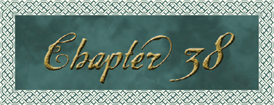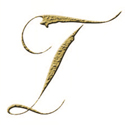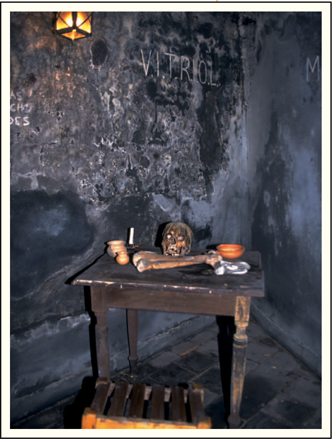
 HIS ROOM is Masonic?” Sato demanded, turning from the skull and staring at Langdon in the darkness.
HIS ROOM is Masonic?” Sato demanded, turning from the skull and staring at Langdon in the darkness.
Langdon nodded calmly. “It’s called a Chamber of Reflection. These rooms are designed as cold, austere places in which a Mason can reflect on his own mortality. By meditating on the inevitability of death, a Mason gains a valuable perspective on the fleeting nature of life.”
Sato looked around the eerie space, apparently not convinced. “This is some kind of meditation room?”
“Essentially, yes. These chambers always incorporate the same symbols—skull and crossed bones, scythe, hourglass, sulfur, salt, blank paper, a candle, et cetera. The symbols of death inspire Masons to ponder how better to lead their lives while on this earth.”
“It looks like a death shrine,” Anderson said.
That’s kind of the point. “Most of my symbology students have the same reaction at first.” Langdon often assigned them Symbols of Freemasonry by Beresniak, which contained beautiful photos of Chambers of Reflection.
“And your students,” Sato demanded, “don’t find it unnerving that Masons meditate with skulls and scythes?”
“No more unnerving than Christians praying at the feet of a man nailed to a cross, or Hindus chanting in front of a four-armed elephant named Ganesh. Misunderstanding a culture’s symbols is a common root of prejudice.”
Sato turned away, apparently in no mood for a lecture. She moved toward the table of artifacts. Anderson tried to light her way with the flashlight, but the beam was beginning to dim. He tapped the heel of the light and coaxed it to burn a little brighter.
As the threesome moved deeper into the narrow space, the pungent tang of sulfur filled Langdon’s nostrils. The subbasement was damp, and the humidity in the air was activating the sulfur in the bowl. Sato arrived at the table and stared down at the skull and accompanying objects. Anderson joined her, doing his best to light the desk with the weakening beam of his flashlight.
Sato examined everything on the table and then placed her hands on her hips, sighing. “What is all this junk?”
The artifacts in this room, Langdon knew, were carefully selected and arranged. “Symbols of transformation,” he told her, feeling confined as he inched forward and joined them at the table. “The skull, or caput mortuum, represents man’s final transformation through decay; it’s a reminder that we all shed our mortal flesh one day. The sulfur and salt are alchemical catalysts that facilitate transformation. The hourglass represents the transformational power of time.” He motioned to the unlit candle. “And this candle represents the formative primordial fire and the awakening of man from his ignorant slumber—transformation through illumination.”

A MASONIC CHAMBER OF REFLECTION
38.1: © Carlos Carrion/Sygma/Corbis
“And … that?” Sato asked, pointing into the corner.
Anderson swung his dimming flashlight beam to the giant scythe that leaned against the back wall.
“Not a death symbol, as most assume,” Langdon said. “The scythe is actually a symbol of the transformative nourishment of nature—the reaping of nature’s gifts.”
Sato and Anderson fell silent, apparently trying to process their bizarre surroundings.
Langdon wanted nothing more than to get out of the place. “I realize this room may seem unusual,” he told them, “but there’s nothing to see here; it’s really quite normal. A lot of Masonic lodges have chambers exactly like this one.”
“But this is not a Masonic lodge!” Anderson declared. “It’s the U.S. Capitol, and I’d like to know what the hell this room is doing in my building.”
“Sometimes Masons set aside rooms like this in their offices or private homes as meditation spaces. It is not uncommon.” Langdon knew a heart surgeon in Boston who had converted a closet in his office into a Masonic Chamber of Reflection so he could ponder mortality before going into surgery.
Sato looked troubled. “You’re saying Peter Solomon comes down here to reflect on death?”
“I really don’t know,” Langdon said sincerely. “Maybe he created it as a sanctuary for his Masonic brothers who work in the building, giving them a spiritual sanctuary away from the chaos of the material world … a place for a powerful lawmaker to reflect before making decisions that affect his fellow man.”
“Lovely sentiment,” Sato said, her tone sarcastic, “but I have a feeling Americans might have a problem with their leaders praying in closets with scythes and skulls.”
Well, they shouldn’t, Langdon thought, imagining how different a world it might be if more leaders took time to ponder the finality of death before racing off to war.
Sato pursed her lips and carefully surveyed all four corners of the dimly lit chamber. “There must be something in here besides human bones and bowls of chemicals, Professor. Someone transported you all the way from your home in Cambridge to be in this precise room.”
Langdon clutched his daybag to his side, still unable to imagine how the package he carried might relate to this chamber. “Ma’am, I’m sorry, but I don’t see anything out of the ordinary here.” Langdon hoped that now at last they could get to the business of trying to find Peter.
Anderson’s light flickered again, and Sato spun on him, her temper starting to show. “For Christ’s sake, is it too much to ask?” She plunged her hand into her pocket and yanked out a cigarette lighter. Striking her thumb on the flint, she held out the flame and lit the desk’s lone candle. The wick sputtered and then caught, spreading a ghostly luminescence throughout the constricted space. Long shadows raked the stone walls. As the flame grew brighter, an unexpected sight materialized before them.
“Look!” Anderson said, pointing.
In the candlelight, they could now see a faded patch of graffiti—seven capital letters scrawled across the rear wall.
![]()
“An odd choice of word,” Sato said as the candlelight cast a frightening skull-shaped silhouette across the letters.
“Actually, it’s an acronym,” Langdon said. “It’s written on the rear wall of most chambers like this as a shorthand for the Masonic meditative mantra: Visita interiora terrae, rectificando invenies occultum lapidem.”
Sato eyed him, looking almost impressed. “Meaning?”
“Visit the interior of the earth, and by rectifying, you will find the hidden stone.”
Sato’s gaze sharpened. “Does the hidden stone have any connection to a hidden pyramid?”
Langdon shrugged, not wanting to encourage the comparison. “Those who enjoy fantasizing about hidden pyramids in Washington would tell you that occultum lapidem refers to the stone pyramid, yes. Others will tell you it’s a reference to the Philosopher’s Stone—a substance alchemists believed could bring them everlasting life or turn lead into gold. Others claim it’s a reference to the Holy of Holies, a hidden stone chamber at the core of the Great Temple. Some say it’s a Christian reference to the hidden teachings of Saint Peter—the Rock. Every esoteric tradition interprets ‘the stone’ in its own way, but invariably the occultum lapidem is a source of power and enlightenment.”
Anderson cleared his throat. “Is it possible Solomon lied to this guy? Maybe he told him there was something down here … and there really isn’t.”
Langdon was having similar thoughts.
Without warning, the candle flame flickered, as if caught by a draft. It dimmed for a moment and then recovered, burning brightly again.
“That’s odd,” Anderson said. “I hope no one closed the door upstairs.” He strode out of the chamber into the darkness of the hallway. “Hello?”
Langdon barely noticed him leave. His gaze had been drawn suddenly to the rear wall. What just happened?
“Did you see that?” Sato asked, also staring with alarm at the wall.
Langdon nodded, his pulse quickening. What did I just see?
A moment earlier, the rear wall seemed to have shimmered, as if a ripple of energy had passed through it.
Anderson now strode back into the room. “No one’s out there.” As he entered, the wall shimmered again. “Holy shit!” he exclaimed, jumping back.
All three stood mute for a long moment, staring in unison at the back wall. Langdon felt another chill run through him as he realized what they were seeing. He reached out tentatively, until his fingertips touched the rear surface of the chamber. “It’s not a wall,” he said.
Anderson and Sato stepped closer, peering intently.
“It’s a canvas,” Langdon said.
“But it billowed,” Sato said quickly.
Yes, in a very strange way. Langdon examined the surface more closely. The sheen on the canvas had refracted the candlelight in a startling manner because the canvas had just billowed away from the room … fluttering backward through the plane of the rear wall.
Langdon extended his outstretched fingers very gently, pressing the canvas backward. Startled, he yanked his hand back. There’s an opening!
“Pull it aside,” Sato ordered.
Langdon’s heart pounded wildly now. He reached up and clutched the edge of the canvas banner, slowly pulling the fabric to one side. He stared in disbelief at what lay hidden behind it. My God.
Sato and Anderson stood in stunned silence as they looked through the opening in the rear wall.
Finally, Sato spoke. “It appears we’ve just found our pyramid.”